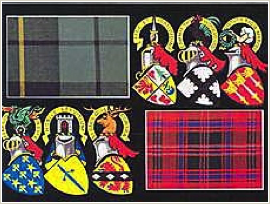The clans and us
I sometimes get asked by my newfound Raitt relations to which clan I belong. We Raitts (and alternative spellings) don’t belong to any clan or sept to the very best of my knowledge.
The origin of the clans, according to Wikipedia (though there are plenty of other sources), is as follows. Although a couple of clans such as Clan Mackinnon and Clan Gregor claim descendancy from Alpin, father of Kenneth MacAlpin, who united the Scottish kingdom in 843, a few, including Clan Sweeney, Clan Lamont, Clan MacLea, Clan MacLachlan and Clan MacNeill, believe they can trace their ancestry back to the fifth century Niall of the Nine Hostages, High King of Ireland. However, in reality the progenitors of clans can rarely be authenticated further back than the 11th century, and a continuity of lineage in most cases cannot be found until the 13th or 14th centuries.
The emergence of clans had more to do with political turmoil than ethnicity.The Scottish Crown’s conquest of Argyll and the Outer Hebrides from the Norsemen in the 13th century, which followed on from the pacification of the Mormaer of Moray and the northern rebellions of the 12th and 13th centuries, created the opportunity for war lords to impose their dominance over local families (who may or may not have been blood relatives or had the same surname) who accepted their protection. These warrior chiefs can largely be categorized as Celtic, however their origins range from Gaelic to Norse-Gaelic and British. By the 14th century there had been further influx of kindreds whose ethnicity ranged from Norman or Anglo-Norman and Flemish (and possibly Germanic!), such as the Clan Cameron, Clan Fraser, Clan Menzies, Clan Chisholm and Clan Grant.
During the Wars of Scottish Independence feudal tenures were introduced by Robert the Bruce (see under Raitt Context) which harnessed and controlled the prowess of clans by the award of charters for land in order to gain support in the national cause against the English. For example the Clan MacDonald were elevated above the Clan MacDougall, two clans who shared a common descent from a great Norse-Gaelic warlord named Somerled of the 12th century. Clanship was thus not only a strong tie of local kinship but also of feudalism to the Scottish Crown. It is this feudal component, reinforced by Scots law that separates Scottish clanship from the tribalism that is found in aboriginal groups in Australasia, Africa and the Americas.
Now, it is interesting to speculate on why the Raitts do not seem to be associated with any clan (not even the similar sounding Clan Macrae or the Comyns around Nairn.) Many clans were highland in nature and the Raitts are not really considered to come from the Highlands of Scotland proper. If we accept my suggestion that perhaps Sir Gervase de Rait and his brother Andrew were third generation as evidenced by the engrailed cross (see under Differencing of Arms on the Heraldic Symbolism page), then that would give perhaps a date of no later than about 1200 for the birth of their grandfather (could that have been Jordan de Raat?) - pretty much before the clan system really got going. Gervase died about 1297 and appears to have been no warlord, nor was his brother - thus presumably they did not offer protection to any families nearby. And because they were knights in positions of authority, aristocrats and men of power, then they had no need to submit to the dominance of another local strongman (clan chief) - except the King himself. Probably the Rait family of this time were also relatively few in number (see the de Rathes of Rait Castle), which might point to them being incomers - possibly Normans or Anglo-Normans - and anyway apparently tied by loyalty to Edward I.
It should also be pointed out that although members of a clan, or septs, may or may not have the same surname as their chief and thus be unrelated, Scottish heraldry operates under the proposition that all those who share the same surname are related, however distantly. And it is reputed that all those bearing the name Raitt and its similar spellings emanate from the Raits who fled from Nairn to The Mearns at the start of the 1400s.
Sunday 16 February 2014

